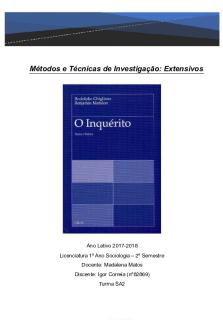The Rite of Spring Igor Stravinsky PDF

| Title | The Rite of Spring Igor Stravinsky |
|---|---|
| Course | StuDocu Summary Library EN |
| Institution | StuDocu University |
| Pages | 2 |
| File Size | 69 KB |
| File Type | |
| Total Downloads | 95 |
| Total Views | 148 |
Summary
The Rite of Spring...
Description
Igor Stravinsky - The Rite of Spring It was Igor Stravinsky who dragged classical music, kicking and screaming, into the twentieth century. Sure, his contemporaries had paved the way. Mahler, Strauss, Rachmaninov and Ravel had all changed music forever. No longer was the Romantic melody-rich work the dominant force. The new way was about orchestral colors and tone painting. But it was Stravinsky who broke altogether with the Romantic past and created Modernism. It was almost as if all the old rules had not just been bent, but completely distroyed. In the modern world, anything goes. Stravinsky made a name for himself at a very early age. In his twenties, his work, Fireworks brought him to the attention of Serge Diaghilev, director of the Ballet Russes, who commissioned from Stravinsky a ballet based on the Firebird legend. It was a huge success and Diaghilev commissioned two more. The results were Petrouchka and The Rite of Spring. These three, very early works defined, even invented, the Modernist style, and they established the young Stravinsky as the pre-eminent composer of the century. The story of the premier of The Rite of Spring is famous. The audience was first treated to Les Sylphides a ballet based on the music of Chopin. The Rite of Spring was to follow. No doubt lulled into a pleasant dreamy state by the earlier work, and expecting something similarly pastoral with the Rite, name after all about the most pelasant of seasons, they were in for a rude shock. A clue comes from its subtitle: Scenes from Pagan Russia. It opened with a bassoon bleating way higher than any bassoon was ever supposed to go, and then descended into 30 minutes of barbarism and pagan ritual sacrifice. The music was jarring, dissonant, difficult. The huge percussion sections pounded out primitive rhythms, and Nijinsky's provocative choreography challenged the audience's sensibilities. From its first bars, hisses, boos and catcalls rang out from the audience, quickly countered by applause from Stravinsky's supporters. Satirical calls for a doctor were heard. Fistfights broke out and pandemonium reigned. Diaghilev tried in vain to calm the crowd by turning the houselights off and back on, no doubt adding to the confusion. Stravinsky himself stormed out in fury, but the conductor, Pierre Monteau and his orchestra bravely played it to the end.
The Synopsis Stravinsky's own description of his inspiration: “I had a fleeting vision that came to me as a complete surprise ... I saw in imagination a solemn pagan rite: sage elders, seated in a circle, watching a young girl dance herself to death. They were sacrificing her to propitate the god of spring”. Part I: The Adoration of the Earth. The curtain rises to reveal young men and women in separate groups. Their surroundings are primitive and dominated by the dark forces of nature. At first the dances are light
hearted but they slowly change to have more aggressive and savage movements. The young men take possession of the women and carry them offstage. A fight ensues until a wise old man makes peace. There is a stunned silence, then the men throw themselves on the ground in worship, rise again, and start an even more frenzied dance. Part II: The Sacrifice. The young women are standing on the stage near a fire, one of them will be chosen as a sacrifice to the earth. The chosen one stands alone and still in the middle of the stage after a mystic dance, and the young members of the tribe gather around her and dance in a "crescendo or brutal excitement." Finally the chosen one joins them and the dancing grows more and more violent until it climaxes and the chosen maiden falls exhausted and dies. The men then carry her over to the sacred stone and fall prostrate. The rite is over....
Similar Free PDFs

The rite of spring
- 4 Pages

Rite of Passage Handout
- 1 Pages

The Gallican Rite
- 3 Pages

Anthropology - Rite of Passage
- 2 Pages

Igor Grubić
- 1 Pages

Content of the spring semester
- 3 Pages

Projeto integrador Igor Kuhn
- 10 Pages

RITE investigacion
- 5 Pages
Popular Institutions
- Tinajero National High School - Annex
- Politeknik Caltex Riau
- Yokohama City University
- SGT University
- University of Al-Qadisiyah
- Divine Word College of Vigan
- Techniek College Rotterdam
- Universidade de Santiago
- Universiti Teknologi MARA Cawangan Johor Kampus Pasir Gudang
- Poltekkes Kemenkes Yogyakarta
- Baguio City National High School
- Colegio san marcos
- preparatoria uno
- Centro de Bachillerato Tecnológico Industrial y de Servicios No. 107
- Dalian Maritime University
- Quang Trung Secondary School
- Colegio Tecnológico en Informática
- Corporación Regional de Educación Superior
- Grupo CEDVA
- Dar Al Uloom University
- Centro de Estudios Preuniversitarios de la Universidad Nacional de Ingeniería
- 上智大学
- Aakash International School, Nuna Majara
- San Felipe Neri Catholic School
- Kang Chiao International School - New Taipei City
- Misamis Occidental National High School
- Institución Educativa Escuela Normal Juan Ladrilleros
- Kolehiyo ng Pantukan
- Batanes State College
- Instituto Continental
- Sekolah Menengah Kejuruan Kesehatan Kaltara (Tarakan)
- Colegio de La Inmaculada Concepcion - Cebu







